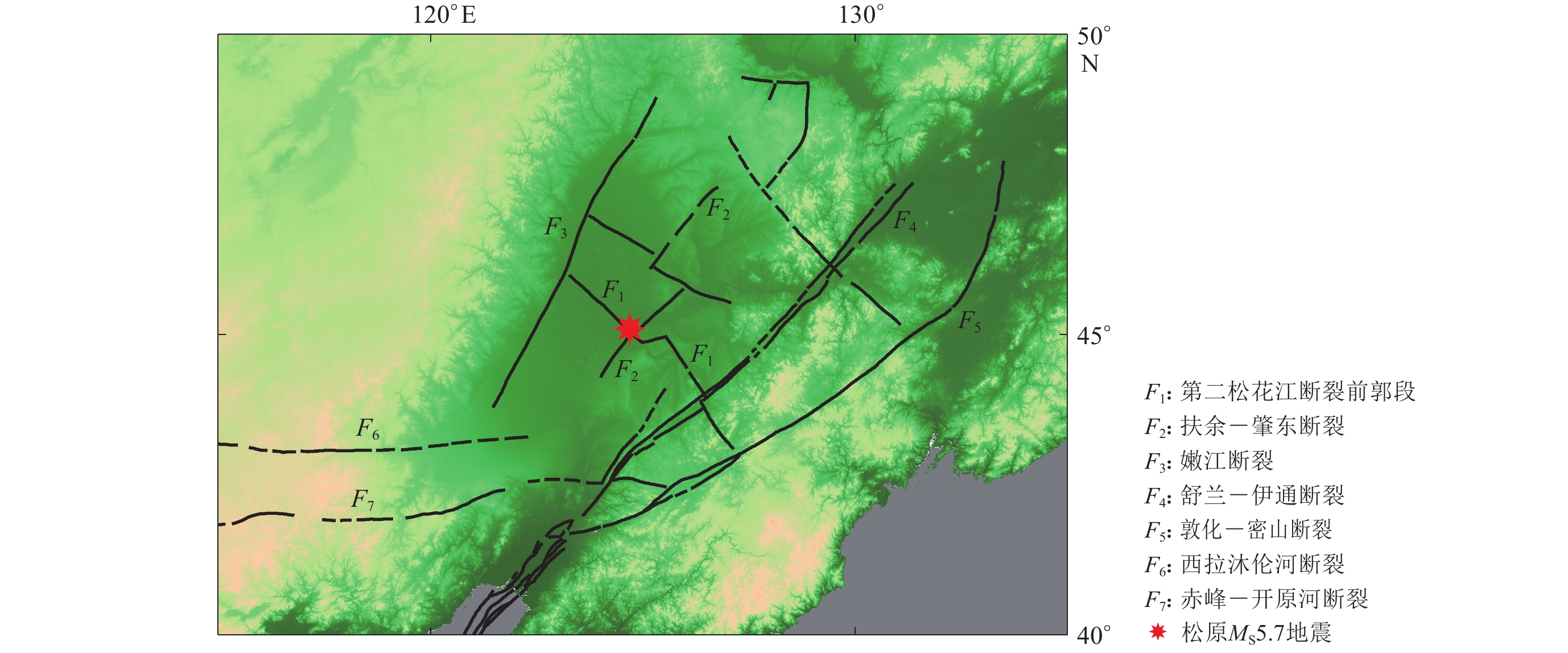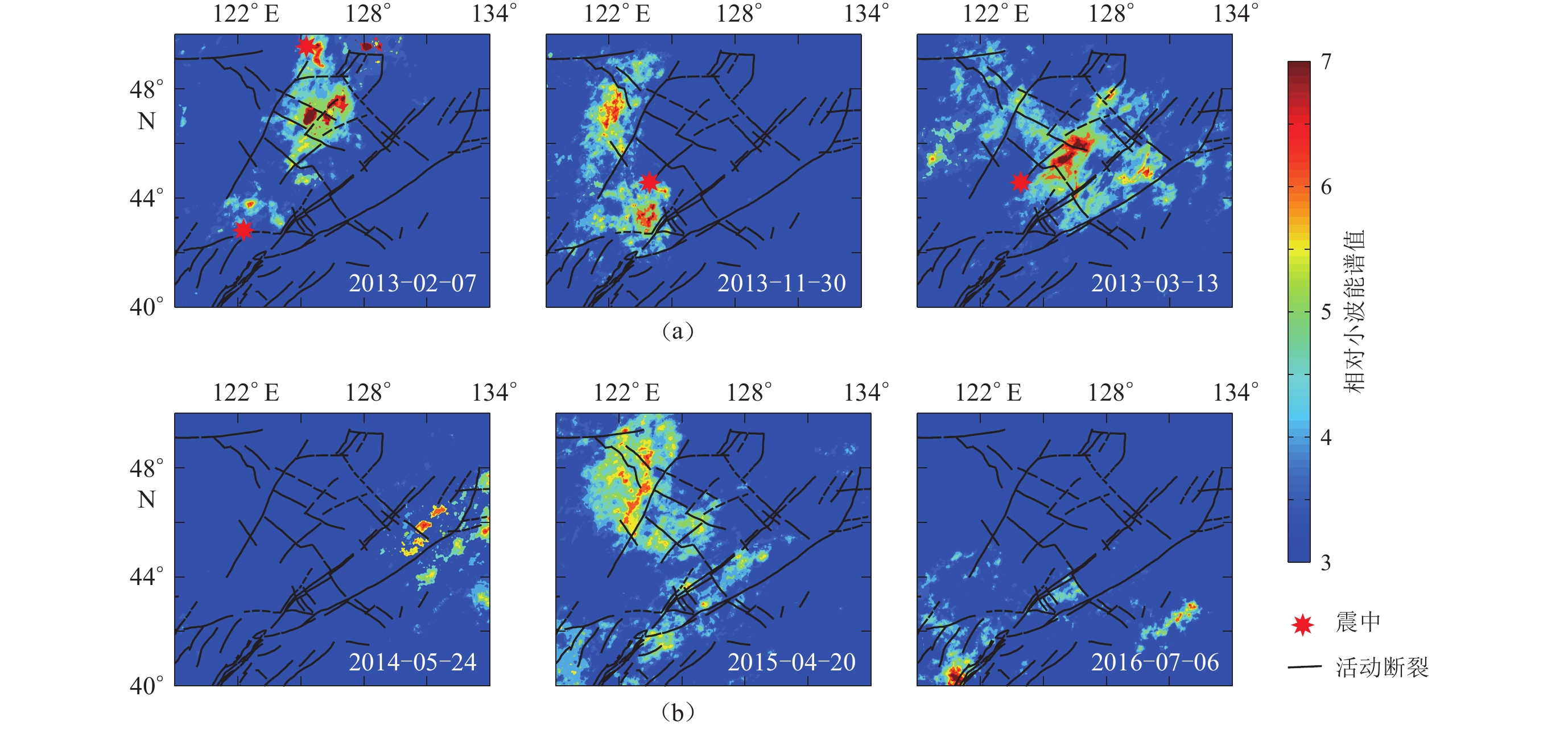Thermal infared brightness temperature anomaly evolution associated with Songyuan MS5.7 earthquake on May 28, 2018
-
摘要: 基于2016年5月29日—2018年5月28日中国静止气象卫星FY-2E (FY-2G)的连续亮温观测数据,利用连续小波变换法分析了2018年5月28日松原MS5.7地震前震中附近(119°E—134°E,40°N—50°N)热红外亮温相对小波能谱的时空演化。结果显示:自2018年2月起,热红外亮温相对小波能谱首先在北西向的第二松花江断裂前郭部分出现高值异常;随后异常范围沿第二松花江断裂前郭部分和扶余—肇东断裂扩展,至2018年3月异常范围及幅值达到峰值;而后异常空间分布逐渐向震中附近收缩成一条NE走向的沿扶余—肇东断裂分布的窄带状区域,异常幅值逐渐降低;最终于4月中旬异常在该区域内消失,其后约40天发生松原MS5.7地震,震中位于异常区域的边缘。此外,本文还分析了2013年以来研究区域内热红外亮温相对小波能谱高值异常与所发生地震的对应关系,结果显示:在7组异常中有4组异常出现后有地震发生,且此4次地震为该时段内研究区内所发生的所有浅源地震。Abstract: This paper analyzes relative wavelet power spectrum (RWPS) of thermal infrared brightness temperature in the vicinity of the epicenter of the Songyuan MS5.7 earthquake on May 28, 2018 (40°N—50°N, 119°E—134°E) by using continuous wavelet transform method based on daily brightness temperature data from Chinese geostationary meteorological satellite FY-2E (FY-2G) during the period from 28 May 2016 to 2 May 2018. The characteristics of spatio-temporal evolution results showed that the thermal infrared bright temperature relative wavelet energy spectrum reached high value along the Second Songhuajiang fault with the NW direction since February of 2018, then anomalous areas gradually enlarged and gathered along the Qianguo segment of the Second Songhuajiang fault and Fuyu-Zhaodong fault. The anomaly amplitude reached maximum in March and attenuated quickly, and then shrinked into a narrow band along Fuyu-Zhaodong fault near the epicenter with anomaly amplitude decreasing gradually and disappeared till 40 days before the Songyuan MS5.7 earthquake. The epicenter is on the edge of the anomaly area. Furthermore, we analyzed thermal infrared brightness anomalies and corresponding earthquakes in the studied area since 2013, and the statistical result showed that four of the seven groups of anomalies correspond to earthquakes which were all the shallow earthquakes occurred in the area during that period.
-
引言
为了尽可能地减少地震灾害造成的损失,多年来地震学家一直专注于地震前兆信息提取和地震预测研究(屈春燕等,2006;马晓静等,2009;张建国等, 2012, 2013;Zhang et al,2017)。Gorny等(1988)分析得出,1984年加兹利MS7.1地震震前曾出现显著的卫星热红外亮温异常,此后,与地震相关的卫星热红外亮温异常研究发展迅速,逐步产生了多种卫星热红外数据分析方法。例如卫星技术稳健估计方法(robust satellite technique,简写为RST)(Tronin et al,2002;Filizzola et al,2004;Ouzounov,Freund,2004;邓志辉等, 2005, 2014;单新建等,2005)、内外温差法(陈顺云等, 2006, 2013;Pulinets et al,2006;陈梅花等,2007;Saraf et al,2008)和相对功率谱方法(张元生等,2010,2011;Blackett et al,2011;Xie et al,2013;解滔等,2015a,b;张治广等,2017a)等。Filizzola等(2004)认为在地震孕育过程中,震中的地表温度高于其它区域,因此采用一种基于统计的RST方法,该方法将研究区的长期背景温度值从研究时段内研究区的亮温数据中减去,从而得到了研究时段的显著温度异常变化,并于1999年雅典MS5.9地震前提取到了显著的异常。为了进一步研究地震孕育过程中断裂带内外温度差异,陈梅花等(2007)以断裂带为界,分析了断裂带内外的温度差异及其与地震的关系,并分析得出2000年姚安MS6.5地震前,红河断裂内外温差呈稳定上升趋势,震后迅速回落至正常水平;张元生等(2010,2011)利用相对功率谱方法提取到了2011年日本MS9.0和2008年汶川MS8.0地震前的热红外亮温异常;Xie等(2013)沿用该相对功率谱方法,采用具有可变时频窗的连续小波变换计算了亮温数据的能谱,不同频段热红外相对小波能谱时空演化特征表明,该方法能够同时兼顾能谱分析的频率和时间分辨率,得到的相对小波能谱变化时频域更为平滑,并能够很好的抑制边界效应。
据中国地震台网中心测定,2018年5月28日1时50分,吉林省松原市宁江区发生MS5.7地震,震中位置为(124.71°E,45.27°N),震源深度为13 km。震中位于松原油气开发区,且处于第二松花江断裂前郭部分与扶余—肇东断裂的交会区(图 1)。地震孕育过程中,断层活动必然会导致CO2,CH4等“温室气体”释放增强,而此类气体极易吸收太阳的直接辐射和地表再发射的红外辐射,故使得地表温度逐渐升高,因此若能够检测到红外异常,一方面可以支持前人关于震前热红外亮温高值异常的研究结果(张元生等,2010;解滔等,2015a,b;张治广等,2017a),另一方面可以更有力地说明红外异常的温室效应机制。此外,由于此次地震震中位于两条断裂带的交会区,不同断裂对本次地震的贡献可通过相应地区热红外演化特征来进行揭示。
基于此,本文拟利用相对小波能谱分析方法,对松原MS5.7地震前(119°E—134°E,40°N—50°N)范围内的静止气象卫星FY-2G,FY-2E在2016年5月29日至2018年5月28日的连续观测亮温数据予以分析,以获取与此次地震相关的地震热红外异常演化特征,以期为进一步探索卫星热红外亮温异常与地震的关系积累研究震例。此外,由于本次地震的余震空间分布并未呈现出与扶余—肇东断裂与第二松花江断裂前郭部分相近的优势分布,因此此次地震的发震构造一直无法确定。本文研究分析得出,热红外相对小波能谱沿着两条断裂衰减,其中沿扶余—肇东断裂衰减较慢,因此可初步认为,扶余—肇东断裂对本次地震的贡献较为显著,可能为进一步揭示发震构造提供佐证。
1. 数据选取和处理方法
1.1 数据选取
本文选取中国静止气象卫星FY-2E和FY-2G (FY-2G为FY-2E的替代卫星)观测的热红外遥感亮温产品数据进行分析(中国气象局国家卫星气象中心,2008)。FY-2E和FY-2G两颗卫星分别于2008年6月15日和2014年12月31日发射,定点于105°E赤道上空,每1小时或30分钟对全球约1/3面积观测1次,红外波段分别为10.3—11.3 μm和11.5—12.5 μm (张璇等,2016;张治广等,2017a,b )。为了避免白天太阳照射导致的地表大幅升温造成的干扰,选取地方时夜间即北京时间00:00—04:00 (GMT 16:00—20:00)时段的5次亮温观测资料进行分析。
1.2 数据处理
小波变换作为一种线性时频分析方法,在频率域和时间域均具有很好的局部化性质,能够较好地解决频率分辨率与时间分辨率的矛盾,因此被广泛应用于地球物理勘探、地震信号处理及地震前兆分析等各项研究中(解滔等,2015a,b;王黎宏,2016)。对于一组有限的时间序列f (t),定义其小波变换为
$ {W_\varPsi }f(a{\text{,}}b) {\text{=}} \int\nolimits_{ {\text{-}} \infty }^{ {\text{+}} \infty } {f(t)\varPsi ^*_{a{\text{,}}b}} (t)\;{\rm{d}}t{\text{,}} $


(1) This page contains the following errors:
error on line 1 at column 1: Start tag expected, '<' not foundBelow is a rendering of the page up to the first error.
$ \varPsi {\rm{(}}\omega {\rm{)}} {\text{=}}\frac {1} {\sqrt[{4}]{{\text{π}}}}{\rm{exp}}{\rm{[}}{ {\text{-}} {\frac {{{(\omega - {\omega _0})}^2}} {2}}}{\rm{]}} {\text{,}} $


(2) This page contains the following errors:
error on line 1 at column 1: Start tag expected, '<' not foundBelow is a rendering of the page up to the first error.
$ {R_W}(a{\text{,}}b) {\text{=}}{\frac {|{W_\varPsi }f(a{\text{,}}b){|^2}} {{\overline W ^2}(a{\text{,}}b)}}{\text{,}} $


(3) This page contains the following errors:
error on line 1 at column 1: Start tag expected, '<' not foundBelow is a rendering of the page up to the first error.
${\overline W ^2}(a{\text{,}}b) {\text{=}} \displaystyle\frac{1}{N}\sum\limits_{l {\text{=}} 0}^{N {\text{-}} 1} {|{W_l}f(a{\text{,}}b){|^2}} {\text{,}} $


(4) This page contains the following errors:
error on line 1 at column 1: Start tag expected, '<' not foundBelow is a rendering of the page up to the first error.
Torrence和Compo (1998)对连续小波变换的边界效应的研究结果表明:小波能谱在接近信号边界处呈明显衰减状态,且衰减时间随着频率降低而变长;而在边界处的实际能谱值相较于利用小波变换获取的相对能谱值高很多,即如果信号在边界表现出能谱高值异常,实际的能谱异常幅值将大于计算结果,因此利用连续小波变换进行数据处理时并不会由于边界效应导致虚假异常的产生(解滔等,2015a,b)。连续小波变换为非正交变换,不仅在时域和频域有混叠,频域内相邻频段信息中也含有重叠的成分,因此本文取频率间隔对尺度因子a=0.5进行离散化处理(Torrence,Compo,1998;解滔等,2015b);然后对所选观测资料的每个像元进行计算,数据时间长度取N=730 (闰年时N=731);之后应用Xie等(2013)改进的连续小波变换对FY-2E和FY-2G卫星亮温观测数据进行处理,计算得到信号相对小波能谱时频信息后,对研究区域(119°E—134°E,40°N—50°N)进行时空扫描,分析异常区域的时空演化特征及其与本次松原MS5.7地震的关系。
当研究区域的像元上空有云层覆盖时,静止卫星FY-2E和FY-2G观测到的数据为云顶的温度,而云层下地表温度要远高于云顶的温度,为了去除云层影响,采用补窗法进行处理(张元生等,2011;解滔等,2015b),即以补窗后整点值的平均值作为像元的日均值。对所有像元进行相同处理,计算得到像元的日均值序列,采用低通滤波器提取温度日均值数据中周期T≥1年的趋势成分,计算二者的均方差,并以1.5倍均方差作为数据下限阈值,去除云层的影响(Xie et al,2013;解滔等,2015b)。本文按照上述数据处理方法,计算了松原MS 5.7地震前两年间所有像元的相对小波能谱值,并对计算结果进行了时频扫描,得到地震前后热红外亮温小波相对能谱的时空演化结果。
2. 结果分析
2.1 2018年5月28日松原MS5.7地震热红外异常分析
为了尽可能地排除离散噪声异常像元的影响,分析可能与地震等构造活动有关的热红外亮温高值异常现象,本文按照以下3条准则进行异常信息判别(解滔等,2015a,b):① 异常像元须聚集成一定范围的异常区域,而非零星离散的分布;② 显著异常持续时间须在15天以上;③ 异常区域须沿构造断裂带分布,特别是活动断裂带。
对所选数据的小波相对能谱的时空变化特征(图 2)进行分析可以看出:2018年5月28日松原MS5.7地震前,震中附近的断裂带出现了明显的热红外亮温异常现象。从空间上看,2018年2月初在震中附近NW向的第二松花江断裂前郭部分出现异常;2018年3月,异常区开始沿NE向的扶余—肇东断裂展布,3月中旬异常空间分布范围达到峰值,随后异常区域逐渐缩小;至2018年4月仅NE向的扶余—肇东断裂区域存在条带状分布的异常区域,直到2018年4月中旬异常消失。异常空间分布呈现出NW向与NE向的条带交会状,即“V”型分布特征,未来震中位于两条带状热红外异常区域在迁移过程中形成的交会带附近。从相对小波能谱异常幅度上看,2018年2月初在震中附近NW向的第二松花江断裂前郭部分出现异常,随后异常幅度逐渐增大,3月中旬异常幅度达到最大,能谱相对变化达到均值的7倍以上,之后异常幅值逐渐衰减,直至2018年4月中旬异常消失,异常持续时间达3个月。本次地震热异常呈现出与以往震例类似的演化过程,即由初始小范围异常发展至大区域高能量异常,随后开始急速减弱的过程(张璇等,2016)。因此,2018年2月至4月于松原地区出现的热红外亮温异常可能与此次松原MS5.7地震有关。
2.2 研究区历史震例分析
尽管地震前震中及附近区域表现出的地表增温异常现象已被大量的观测结果所证实,但由于地震孕育机理的复杂性和地震热红外异常的多样性,地震热红外成因机理的研究仍然是一个难点(解滔等,2015a)。郭增建和秦保燕(1979)认为,大震震源区锁住的断层会发生预滑移,沿断层带的温度会升高,因而产生震前热红外亮温异常现象。Cicerone等(2009)讨论了地震前卫星热红外亮温异常现象,结果显示,在富含地热和油气的区域地震前出现热红外亮温异常现象的可能性更大,因此解滔等(2015b)分析得出,地震孕育过程中应力逐渐增大,当应力接近岩石临界破裂状态时,会出现大量贯通地表的裂隙,地下逸出气体也随之增多,导致地下岩层与地表的热对流加强。大量裂隙的出现及热对流的增强导致了地震前热红外异常的产生,且异常区沿震中附近的断裂带集中分布(Tronin,1996,2000;马瑾等,2006;强祖基等,2009,2010;解滔等,2015b)。
需要特别说明,热红外异常只是表明在异常时段该区域地表温度较正常背景出现了异常变化,而温度变化并非仅由地震所致,因此,地震热异常分析过程中不可避免地会出现虚假地震异常现象。本文将2013年以来研究区域内热红外亮温异常与地震对应关系列于表 1。在2013年1月至2018年5月期间,依据本文的异常判别准则,该研究区内共出现了7组热红外亮温相对能谱异常,其中3组异常出现后无地震对应,另外4组分别对应于2013年4月22日内蒙古与辽宁交界处的MS5.3地震、2013年6月20日内蒙古与黑龙江交界处MS5.0地震、2013年10月31至11月23日吉林松原市前郭MS5.8震群和本次2018年5月28日松原MS5.7地震,这4组地震前均在震中附近出现了亮温热红外相对能谱高值异常,且地震均发生在异常区边缘。在2013年1月至2018年5月期间,研究区域内共发生MS≥5.0地震5组,除上述4组地震外,还有2016年1月2日发生在黑龙江省牡丹江市林口县的MS6.4地震,该次地震的震源深度为580 km,为深源地震,但风云卫星没有记录到该地震产生的亮温异常。为便于对比分析,选取异常幅值最大的日期作为异常极值日,有震异常和无震异常的极值空间分布如图 3所示。可以看出,有震异常空间分布较为聚集,异常幅值较大,而无震异常空间分布较有震异常更零散,异常幅值相对较小。
表 1 2013—2018年研究区热红外亮温异常与地震对应情况Table 1. The thermal infrared anomaly and corresponding earthquakes in the studied area异常出现时间 异常空间范围 对应地震 2013年1—3月 121°E—123°E,42°N—44°N 2013年4月22日内蒙古与辽宁交界MS5.3地震 2013年2—3月 124°E—126°E,46°N—50°N 2013年6月20日内蒙古与黑龙江交界MS5.0地震 2013年10—12月 121°E—124°E,42°N—46°N 2013年10月31日—11月23日吉林省松原市前郭MS5.8震群 2014年4—7月 129°E—131°E,44°N—46°N 无 2015年3—5月 121°E—122°E,47°N—49°N 无 2016年6—7月 121°E—122°E,40°N—41°N 无 2018年2—4月 125°E—127°E,44°N—46°N 2018年5月28日吉林松原MS5.7地震 ![]() 图 3 历史地震及热红外相对能谱极值的空间分布(a) 有震异常相对能谱极值空间分布;(b) 无震异常相对能谱极值空间分布Figure 3. Spatial distribution of thermal infrared extreme value anomaly and history earthquakes(a) Spatial distribution of thermal infrared extreme value anomaly and corresponding earthquakes;(b) Spatial distribution of thermal infrared extreme value anomaly without corresponding earthquakes
图 3 历史地震及热红外相对能谱极值的空间分布(a) 有震异常相对能谱极值空间分布;(b) 无震异常相对能谱极值空间分布Figure 3. Spatial distribution of thermal infrared extreme value anomaly and history earthquakes(a) Spatial distribution of thermal infrared extreme value anomaly and corresponding earthquakes;(b) Spatial distribution of thermal infrared extreme value anomaly without corresponding earthquakes距离松原MS5.7地震最近的为2013年10月31日至11月23日松原MS5.8震群,两次地震震中相距仅为88 km。本文以该震群为例,对比分析了两组地震前后热红外亮温异常特征及其差异,如图 4所示。从异常及发震时间上看,松原MS5.7地震发生于热红外亮温异常消失后约1个月,而2013年10月31日至11月23日松原MS5.8震群发生在异常出现至异常幅值逐渐增大的过程中,地震后异常幅值逐渐减小。从空间上看,两组地震均发生在异常区边缘,且邻近异常衰减最慢区域。不同的是,2018年5月28日松原MS5.7地震前出现的热红外亮温异常呈现出显著的沿发震构造分布的特点,即异常主要沿第二松花江断裂前郭地区和扶余—肇东断裂展布,而2013年松原震群前异常首先出现在震中距较远的嫩江断裂,其后才出现在北东向的扶余—肇东断裂处。这种大范围远距离的热红外亮温异常可能与地下逸出气体增多以及地下岩层与地表的热对流增强有关(徐秀登等,1991;强祖基等,1992;Tronin,1996,2000)。
3. 讨论与结论
本文针对2018年5月28日吉林松原MS5.7地震,利用连续小波相对能谱方法对发震前两年期间中国静止气象卫星FY-2E (FY-2G)连续观测的亮温资料进行分析,分析结果显示,在震中附近的第二松花江断裂前郭段及扶余—肇东断裂区域均在震前出现显著的相对小波能谱高值异常。震前两个月左右异常幅值和规模开始衰减并于4月中旬消失。地震震中位于异常区边缘的活动断层上,发震时间为异常峰值后的两个月内,与前人的研究结果基本一致。因而认为本文讨论的2018年2月至4月松原地区热红外异常可能与松原MS5.7地震有关。通过对2013年以来研究区历史地震及其与热红外亮温相对小波能谱高值异常的统计可初步发现,有震异常的相对小波能谱高值异常在空间上通常较为集中,呈聚集分布,且异常幅值较高;而无震异常的相对小波能谱高值异常空间上分布较为零星,异常幅值也较低。但由于统计样本个数的限制,目前还无法定量给出两者之间的差别,更多异常特征和异同需要基于更大样本的统计。因此,下一步拟基于中国大陆地区历史地震开展有震异常和无震异常的定量分析。
-
图 3 历史地震及热红外相对能谱极值的空间分布
(a) 有震异常相对能谱极值空间分布;(b) 无震异常相对能谱极值空间分布
Figure 3. Spatial distribution of thermal infrared extreme value anomaly and history earthquakes
(a) Spatial distribution of thermal infrared extreme value anomaly and corresponding earthquakes;(b) Spatial distribution of thermal infrared extreme value anomaly without corresponding earthquakes
表 1 2013—2018年研究区热红外亮温异常与地震对应情况
Table 1 The thermal infrared anomaly and corresponding earthquakes in the studied area
异常出现时间 异常空间范围 对应地震 2013年1—3月 121°E—123°E,42°N—44°N 2013年4月22日内蒙古与辽宁交界MS5.3地震 2013年2—3月 124°E—126°E,46°N—50°N 2013年6月20日内蒙古与黑龙江交界MS5.0地震 2013年10—12月 121°E—124°E,42°N—46°N 2013年10月31日—11月23日吉林省松原市前郭MS5.8震群 2014年4—7月 129°E—131°E,44°N—46°N 无 2015年3—5月 121°E—122°E,47°N—49°N 无 2016年6—7月 121°E—122°E,40°N—41°N 无 2018年2—4月 125°E—127°E,44°N—46°N 2018年5月28日吉林松原MS5.7地震 -
陈梅花,邓志辉,马晓静,陶京玲,王煜. 2007. 断裂带内外温差法在震前红外异常研究中的应用[J]. 地震地质,29(4):863–872. doi: 10.3969/j.issn.0253-4967.2007.04.017 Chen M H,Deng Z H,Ma X J,Tao J L,Wang Y. 2007. Application of the inside-outside temperature relation analysis method in study on satellite infrared anomalies prior to earthquake[J]. Seismology and Geology,29(4):863–872 (in Chinese).
陈顺云,刘培洵,刘力强,马瑾,陈国强. 2006. 地表热红外辐射的小波分析及其在现今构造活动研究中的意义[J]. 地球物理学报,49(3):824–830. doi: 10.3321/j.issn:0001-5733.2006.03.026 Chen S Y,Liu P X,Liu L Q,Ma J,Chen G Q. 2006. Wavelet analysis of thermal infrared radiation of land surface and its implication in the study of current tectonic activities[J]. Chinese Journal of Geophysics,49(3):824–830 (in Chinese).
陈顺云,马瑾,刘培洵,刘力强,扈小燕. 2013. 利用Terra和Aqua卫星地表温度探索汶川地震同震热响应[J]. 地球物理学报,56(11):3788–3799. doi: 10.6038/cjg20131120 Chen S Y,Ma J,Liu P X,Liu L Q,Hu X Y. 2013. Exploring co-seismic thermal response of Wenchuan earthquake by using land surface temperatures of Terra and Aqua satellites[J]. Chinese Journal of Geophysics,56(11):3788–3799 (in Chinese).
邓志辉,陈梅花,王煜. 2005. 卫星热遥感技术在地震预测中应用研究进展[J]. 大地测量与地球动力学,25(2):46–51. Deng Z H,Chen M H,Wang Y. 2005. Review of applying satellite thermally remote sensing technology to earthquake prediction[J]. Journal of Geodesy and Geodynamics,25(2):46–51 (in Chinese).
邓志辉,陈梅花,杨竹转,严兴,邓远立. 2014. 芦山地震、汶川地震与龙门山地区水汽异常[J]. 地震地质,36(3):658–666. doi: 10.3969/j.issn.0253-4967.2014.03.009 Deng Z H,Chen M H,Yang Z Z,Yan X,Deng Y L. 2014. Water vapor anomalies related to the Lushan and Wenchuang earthquakes in the Longmenshan mountains area[J]. Seismology and Geology,36(3):658–666 (in Chinese).
郭增建, 秦保燕. 1979. 震源物理[M]. 北京: 地震出版社: 1−274. Guo Z J, Qin B Y. 1979. Physics of the Earthquake Focus[M]. Beijing: Seismological Press: 1−274 (in Chinese).
马瑾,陈顺云,刘培洵,汪一鹏,刘力强. 2006. 用卫星热红外信息研究关联断层活动的时空变化:以南北地震构造带为例[J]. 地球物理学报,49(3):816–823. doi: 10.3321/j.issn:0001-5733.2006.03.025 Ma J,Chen S Y,Liu P X,Wang Y P,Liu L Q. 2006. Temporal-spatial variations of associated faulting inferred from satellite infrared information: A case study of the N-S seismo-tectonic zone in China[J]. Chinese Journal of Geophysics,49(3):816–823 (in Chinese).
马晓静,邓志辉,陈梅花,杨竹转,高祥林. 2009. 从卫星红外亮温与大地热流的关系看地震前的热红外异常[J]. 地球物理学报,52(11):2746–2751. Ma X J,Deng Z H,Chen M H,Yang Z Z,Gao X L. 2009. A perspective to thermal infrared anomalies before earthquakes from the relationship between satellite infrared brightness temperature and terrestrial heat flow[J]. Chinese Journal of Geophysics,52(11):2746–2751 (in Chinese).
强祖基,孔令昌,王弋平,李秋珍,赁常恭,徐秀登. 1992. 地球放气、热红外异常与地震活动[J]. 科学通报,37(24):2259–2262. Qiang Z J,Kong L C,Wang Y P,Li Q Z,Qian C G,Xu X D. 1992. Earth deflation,thermal infrared anomalies and seismic activity[J]. Chinese Science Bulletin,37(24):2259–2262 (in Chinese).
强祖基,姚清林,魏乐军,曾佐勋,郭坚峰. 2009. 从震前卫星热红外图像看中国现今构造应力场特征[J]. 地球学报,30(6):873–884. doi: 10.3321/j.issn:1006-3021.2009.06.020 Qiang Z J,Yao Q L,Wei L J,Zeng Z X,Guo J F. 2009. The characteristic of current stress hot field by satellite thermal infrared image in China[J]. Acta Geoscientica Sinica,30(6):873–884 (in Chinese).
强祖基,马蔼乃,曾佐勋,王杰. 2010. 卫星热红外地震短临预测方法研究[J]. 地学前缘,17(5):254–262. Qiang Z J,Ma A N,Zeng Z X,Wang J. 2010. A study of the method of satellite thermal infrared earthquake prediction in imminence[J]. Earth Science Frontiers,17(5):254–262 (in Chinese).
屈春燕,马瑾,单新建. 2006. 一次卫星热红外地震前兆现象的证伪[J]. 地球物理学报,49(2):490–495. doi: 10.3321/j.issn:0001-5733.2006.02.022 Qu C Y,Ma J,Shan X J. 2006. Counterevidence for an earthquake precursor of satellite thermal infrared anomalies[J]. Chinese Journal of Geophysics,49(2):490–495 (in Chinese).
单新建,李建华,马超. 2005. 昆仑山口西MS8.1级地震地表破裂带高分辨率卫星影像特征研究[J]. 地球物理学报,48(2):321–326. doi: 10.3321/j.issn:0001-5733.2005.02.013 Shan X J,Li J H,Ma C. 2005. Study on the feature of surface rupture zone of the west of Kunlunshan pass earthquake (MS8.1) with high spatial resolution satellite images[J]. Chinese Journal of Geophysics,48(2):321–326 (in Chinese).
王黎宏. 2016. 基于次声波的油气管道泄漏检测系统研究[D]. 西安: 西安石油大学: 35−36. Wang L H. 2016. Research on Oil-Gas Pipeline Leak Detection System Based on Infrasonic Wave[D]. Xi’an: Xi’an Shiyou University: 35−36 (in Chinese).
解滔,康春丽,卢军,马未宇. 2013. 2012年彝良MS5.7和MS5.6级地震热辐射亮温异常分析[J]. 地球物理学进展,28(5):2322–2327. Xie T,Kang C L,Lu J,Ma W Y. 2013. Study of brightness temperature anomalies of Yiliang (China) MS5.7 and MS5.6 earthquakes on 7 Sept.,2012[J]. Progress in Geophysics,28(5):2322–2327 (in Chinese).
解滔,郑晓东,康春丽,马未宇,卢军. 2015a. 2013年4月20日芦山MS7.0地震前热红外亮温异常分析[J]. 地震地质,37(1):149–161. Xie T,Zheng X D,Kang C L,Ma W Y,Lu J. 2015a. Possible thermal brightness temperature anomalies associated with the Lushan (China) MS7.0 earthquake on 20 April 2013[J]. Seismology and Geology,37(1):149–161 (in Chinese).
解滔,郑晓东,康春丽,卢军,马未宇. 2015b. 2014年2月12日新疆于田MS7.3地震热红外亮温异常分析[J]. 中国地震,31(1):101–109. Xie T,Zheng X D,Kang C L,Lu J,Ma W Y. 2015b. Possible thermal brightness temperature anomalies associated with the Yutian,Xinjiang MS7.3 earthquake on February 12,2014[J]. Earthquake Research in China,31(1):101–109 (in Chinese).
徐秀登,强祖基,赁常恭. 1991. 非增温背景下的热红外异常兼机制讨论[J]. 科学通报,36(11):841–844. Xu X D,Qiang Z J,Dian C G. 1991. Thermal infrared anomalies under the non-temperature-increment background and the mecha-nism discussion[J]. Chinese Science Bulletin,36(22):1901–1906.
张建国,姚丽,刘晓灿,马新欣,焦立果. 2012. 地震电离层VLF电磁场频谱特征研究[J]. 大地测量与地球动力学,32(3):110–115. Zhang J G,Yao L,Liu X C,Ma X X,Jiao L G. 2012. Research on frequency spectrum characteristics of VLF electromagnetic field in earthquake ionosphere[J]. Journal of Geodesy and Geodynamics,32(3):110–115 (in Chinese).
张建国,焦立果,刘晓灿,马新欣. 2013. 汶川MS8.0级地震前后ULF电磁辐射频谱特征研究[J]. 地球物理学报,56(4):1253–1261. Zhang J G,Jiao L G,Liu X C,Ma X X. 2013. A study on the characteristics of ULF electromagnetic spectrum before and after the Wenchuan MS8.0 earthquake[J]. Chinese Journal of Geophysics,56(4):1253–1261 (in Chinese).
张璇,张元生,田洁,张俏丽. 2016. 2016年3月21日甘肃金塔4.7级地震热红外亮温异常分析[J]. 地震工程学报,38(增刊2):212–217. Zhang X,Zhang Y S,Tian J,Zhang Q L. 2016. Analysis of thermal infrared anomaly in Gansu Jinta MS4.7 earthquake on March 21,2016[J]. China Earthquake Engineering Journal,38(S2):212–217 (in Chinese).
张元生,郭晓,钟美娇,沈文荣,李稳,何斌. 2010. 汶川地震卫星热红外亮温变化[J]. 科学通报,55(10):904–910. Zhang Y S,Guo X,Zhong M J,Shen W R,Li W,He B. 2010. Wenchuan earthquake: Brightness temperature changes from satellite infrared information[J]. Chinese Science Bulletin,55(18):1917–1924. doi: 10.1007/s11434-010-3016-8
张元生,郭晓,魏从信,沈文荣,惠少兴. 2011. 日本9级和缅甸7.2级地震热辐射表现特征[J]. 地球物理学报,54(10):2575–2580. doi: 10.3969/j.issn.0001-5733.2011.10.014 Zhang Y S,Guo X,Wei C X,Shen W R,Hui S X. 2011. The characteristics of seismic thermal radiation of Japan MS9.0 and Myanmar MS7.2 earthquake[J]. Chinese Journal of Geophysics,54(10):2575–2580 (in Chinese).
张治广,张元生,王在华,徐衍刚. 2017a. 阿克陶MS6.7和且末MS5.8地震前红外亮温异常分析[J]. 内陆地震,31(2):130–137. Zhang Z G,Zhang Y S,Wang Z H,Xu Y G. 2017a. Analysis of thermal infrared brightness temperature precursory anomaly before Aketao MS6.7 and Qiemo MS5.8 earthquakes[J]. Inland Earthquake,31(2):130–137 (in Chinese).
张治广,张璇,张元生,王在华. 2017b. 2017年8月9日精河MS6.6地震热红外亮温异常分析[J]. 中国地震,33(4):757–763. Zhang Z G,Zhang X,Zhang Y S,Wang Z H. 2017b. Analysis of thermal infrared brightness temperature precursory anomaly before the Jinghe MS6.6 earthquake on August 9,2017[J]. Earthquake Research in China,33(4):757–763 (in Chinese).
中国气象局国家卫星气象中心. 2008. 国家卫星气象中心数据服务[DB/OL]. [2018-06-12]. http://satellite.nsmc.org.cn/PortalSite/Default.aspx. National Satellite Meteorological Center of China Meteorological Administration. 2018. Data service of National Satellite Meteorological Center[DB/OL]. [2018-06-12]. http://satellite.nsmc.org.cn/PortalSite/Default.aspx(in Chinese).
Blackett M,Wooster M J,Malamud B D. 2011. Exploring land surface temperature earthquake precursors: A focus on the Gujarat(India) earthquake of 2001[J]. Geophys Res Lett,38(15):L15303.
Cicerone R D,Ebel J E,Britton J. 2009. A systematic compilation of earthquake precursors[J]. Tectonophysics,476(3/4):371–396.
Filizzola C,Pergola N,Pietrapertosa C,Tramutoli V. 2004. Robust satellite techniques for seismically active areas monitoring: A sensitivity analysis on September 7,1999 Athens’s earthquake[J]. Phys Chem Earth,29(4/5/6/7/8/9):517–527.
Frage M. 1992. Wavelet transform and their application to tuabulence[J]. Annu Rev Fluid Mech,24(1):395–458. doi: 10.1146/annurev.fl.24.010192.002143
Gorny V I,Sal’Man A G,Tronin A A,Shlin B V. 1988. The earth’s outgoing IR radiation as an indicator of seismic activity[J]. Proc Acad Sci USSR,30(1):67–69.
Ouzounov D,Freund F. 2004. Mid-infrared emission prior to strong earthquakes analyzed by remote sensing data[J]. Adv Space Res,33(3):268–273. doi: 10.1016/S0273-1177(03)00486-1
Pulinets S A,Ouzounov D,Karelin A V,Boyarchuk K A,Pokhmelnykh L A. 2006. The physical nature of thermal anomalies observed before strong earthquakes[J]. Phys Chem Earth,31(4/5/6/7/8/9):143–153.
Saraf A K,Rawat V,Banerjee P,Choudhury S,Panda S K,Dasgupta S,Das J D. 2008. Satellite detection of earthquake thermal infrared precursors in Iran[J]. Nat Hazards,47(1):119–135. doi: 10.1007/s11069-007-9201-7
Torrence C,Compo G P. 1998. A practical guide to wavelet analysis[J]. Bull Am Meteor Soc,79(1):61–78. doi: 10.1175/1520-0477(1998)079<0061:APGTWA>2.0.CO;2
Tronin A A. 1996. Satellite thermal survey:A new tool for the study of seismoactive regions[J]. Int J Remote Sens,17(8):1439–1455. doi: 10.1080/01431169608948716
Tronin A A. 2000. Thermal IR satellite sensor data application for earthquake research in China[J]. Int J Remote Sens,21(16):3169–3177. doi: 10.1080/01431160050145054
Tronin A A,Hayakawa M,Molchanov O A. 2002. Thermal IR satellite data application for earthquake research in Japan and China[J]. J Geodyn,33(4/5):519–534.
Xie T,Kang C L,Ma W Y. 2013. Thermal infrared brightness temperature anomalies associated with the Yushu (China) MS=7.1 earthquake on 14 April 2010[J]. Nat Hazards Earth Syst Sci,13(4):1105–1111. doi: 10.5194/nhess-13-1105-2013
Zhang J G,Wu X P,Yang X D,Du W,Yue M X. 2017. Observational evidence of anisotropic changes of apparent resistivity before strong earthquakes[J]. Geophys J Int,210(3):1323–1331. doi: 10.1093/gji/ggx235
-
期刊类型引用(3)
1. 李继业,胡澜缤,李营,马龙辰,王强,张思萌,李冬妮. 松原M_S5.1地震前断层土壤气H_2、Hg地球化学特征与热红外异常响应研究. 地震工程学报. 2023(04): 933-945 .  百度学术
百度学术
2. 李利波,张翔,李智蓉. 2021年云南省3次中强地震前后热红外异常特征分析. 地震地磁观测与研究. 2022(05): 16-22 .  百度学术
百度学术
3. 米日阿依·买土地,玉素甫江·如素力,喀迪阿依·阿力木,艾尔肯·图尔孙. 基于STL和GESD算法的于田两次Ms7.3地震热异常时空分布特征识别研究. 河南科学. 2021(03): 421-428 .  百度学术
百度学术
其他类型引用(2)





 下载:
下载:



